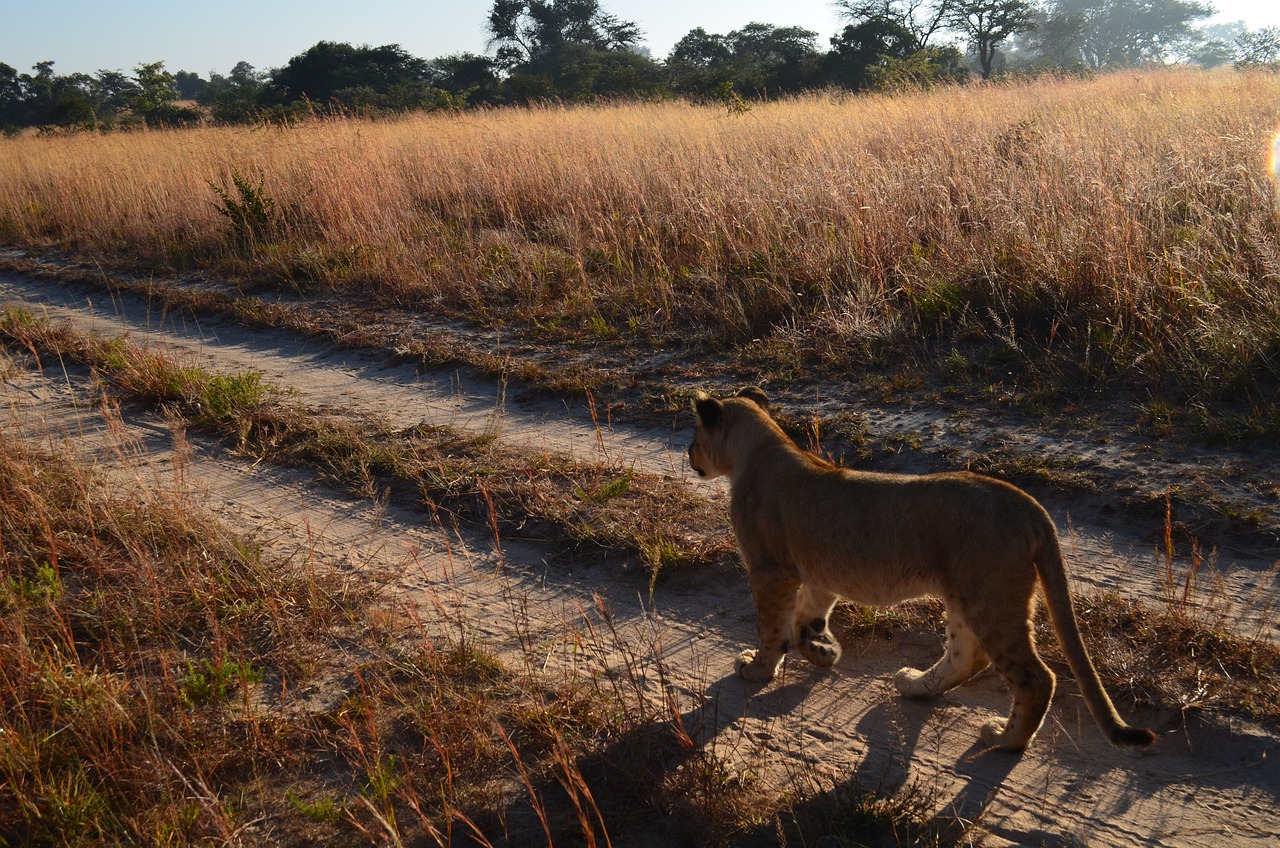How to Protect Your Pet from Wildlife Encounters
As pet owners, we cherish our furry friends and want to ensure their safety at all times, especially when they are outdoors. However, wildlife encounters can pose significant risks to our beloved pets. From curious raccoons to stealthy coyotes, the wild can be unpredictable, and it’s essential to be proactive in safeguarding our pets. In this article, we will explore effective strategies to protect your pet from wildlife encounters, allowing them to enjoy the great outdoors while keeping them safe from potential dangers.
Before diving into protective measures, it’s vital to recognize the types of wildlife that can threaten our pets. Common culprits include:
- Coyotes: These cunning creatures are known to prey on small pets, especially during dusk and dawn.
- Raccoons: Often seen rummaging through trash, raccoons can be aggressive if cornered and may carry diseases.
- Foxes: While generally shy, foxes can pose a risk to smaller pets and are known to be territorial.
- Birds of Prey: Larger birds, such as hawks and eagles, can target small animals, especially in open areas.
Understanding these risks allows pet owners to take informed steps to protect their pets from potential encounters.
Implementing preventative strategies can significantly reduce the chances of wildlife encounters. One of the most effective ways is through proper leash training. When your pet is on a leash, you maintain control over their movements, preventing them from wandering into risky areas. This is especially important in regions where wildlife is prevalent. A well-trained pet will respond to your commands, keeping them safe from unexpected wildlife interactions.
Proper leash training is vital for pet safety. A pet that is accustomed to walking on a leash will be less likely to dart away and encounter wildlife. Establishing a strong bond of communication through training can be a lifesaver. Consider using positive reinforcement techniques, rewarding your pet with treats or praise when they walk calmly on a leash. This not only builds their confidence but also reinforces good behavior.
Selecting an appropriate leash can enhance control during walks. There are various types of leashes available, each with its own benefits:
| Type of Leash | Benefits |
|---|---|
| Standard Leash | Offers maximum control; ideal for training. |
| Retractable Leash | Allows for more freedom while maintaining control; best used in safe areas. |
| Martingale Leash | Prevents pets from slipping out; great for escape artists. |
Choosing the right leash for your pet's size and behavior can make a significant difference in ensuring their safety in wildlife-prone areas.
Setting clear boundaries can help keep your pet safe. Training your pet to respect physical boundaries, such as staying within the yard or designated areas, can be crucial. Use commands like "stay" or "leave it" to reinforce these boundaries. Consistency is key; the more you practice, the more instinctive these commands will become for your pet.
Designing a secure outdoor environment is essential for pet safety. Consider the following tips to create a wildlife-proof yard or garden:
- Fencing: Install a sturdy fence that is tall enough to deter jumping and deep enough to prevent digging.
- Plant Selection: Choose plants that are less attractive to wildlife, avoiding those that bear fruit or nuts.
- Food Storage: Keep pet food indoors and secure trash bins to avoid attracting wildlife.
By implementing these measures, you can create a safe haven for your pet while minimizing the risk of wildlife encounters.
Being aware of wildlife signs can help you anticipate encounters. Look for tracks, droppings, and sounds that may indicate the presence of wildlife nearby. For example, fresh tracks in the mud or snow can signal recent activity in your area. Listening for rustling in bushes or unusual animal calls can also provide clues. Being vigilant allows you to take preemptive actions to keep your pet safe.
Training your pet to respond to wildlife can save their life. Consider enrolling your pet in obedience classes that focus on commands useful in wildlife encounters. Teaching commands like "come," "leave it," and "stay" can help you manage your pet’s behavior when faced with unexpected wildlife. Positive reinforcement will encourage your pet to respond quickly and appropriately.
Knowing what to do in case of an encounter is crucial. If your pet comes face-to-face with wildlife, remain calm and assess the situation. Here are some steps to take:
- Keep your pet on a leash and try to lead them away slowly.
- Make loud noises to scare off the wildlife without startling your pet.
- If your pet is injured, administer first aid if you are trained, and seek veterinary care immediately.
Being prepared can make a significant difference in ensuring your pet's safety during unexpected wildlife encounters.
Q: What should I do if my pet encounters wildlife?
A: Stay calm, keep your pet on a leash, and try to lead them away slowly. Make loud noises to scare off the wildlife if necessary.
Q: How can I tell if wildlife is nearby?
A: Look for signs such as tracks, droppings, or sounds like rustling in bushes. Being aware of your surroundings can help you anticipate encounters.
Q: Is leash training really necessary?
A: Yes! Proper leash training is vital for keeping your pet safe and under control, especially in areas where wildlife may be present.
Q: How can I create a wildlife-proof yard?
A: Install sturdy fencing, choose less attractive plants, and secure food sources to minimize the risk of wildlife intrusion.

Understanding Wildlife Risks
When we think about our beloved pets frolicking in the great outdoors, we often envision playful moments filled with joy and freedom. However, lurking beneath this idyllic image are potential dangers posed by wildlife. Understanding these risks is crucial for every pet owner. Various wild animals can pose threats to your furry friends, and it's essential to be aware of their presence in your area. From coyotes and raccoons to snakes and even larger creatures like bears, each type of wildlife presents unique challenges and risks.
For instance, coyotes are known for their adaptability and can sometimes venture into urban areas in search of food. They can pose a significant risk, especially to small dogs and cats. Similarly, raccoons may seem harmless, but they can carry diseases such as rabies and can be aggressive if they feel cornered. It’s not just the obvious threats that pet owners need to be wary of; even seemingly innocuous animals can create dangerous situations. For example, snakes can deliver painful bites, and some species are venomous, posing a severe risk to pets that may not understand the danger.
Moreover, pets can inadvertently provoke wildlife. A curious dog may chase after a rabbit, only to find itself in a confrontation with a more dangerous animal. This instinctual behavior can lead to serious injuries or worse. Understanding the behavior of local wildlife can help you anticipate potential encounters. For instance, knowing that deer often roam during dawn and dusk can help you time your pet walks accordingly.
Additionally, it’s essential to recognize the signs of wildlife presence in your area. Tracks, droppings, and even sounds can indicate that wildlife is nearby. Familiarizing yourself with these signs can help you take preventative measures. In the table below, we summarize some common wildlife and their associated risks:
| Wildlife | Potential Risks |
|---|---|
| Coyotes | Attacks on small pets, disease transmission |
| Raccoons | Rabies, aggressive behavior |
| Snakes | Venomous bites, injuries |
| Foxes | Predation on small pets, disease |
| Deer | Vehicle collisions, tick-borne diseases |
Ultimately, being aware of these wildlife risks and understanding the behaviors and habits of local animals can significantly enhance your pet's safety. By staying informed and proactive, you can create a safer environment for your furry companions while still allowing them to enjoy the great outdoors. Remember, the goal is not to instill fear but to foster a sense of caution and preparedness. After all, a little knowledge goes a long way in ensuring the safety and well-being of our pets.

Preventative Measures
When it comes to keeping your furry friends safe from wildlife encounters, implementing is key. Just like how we take precautions to protect ourselves from potential dangers, our pets deserve the same level of care. Imagine taking your dog for a stroll in the park, only to have them come face-to-face with a curious raccoon or a startled deer. Yikes! That’s a scenario we want to avoid at all costs. So, how do we ensure that our pets stay safe while enjoying the great outdoors? Let’s dive into some practical tips and techniques that can make a significant difference.
First and foremost, leash training is an essential aspect of pet safety. It’s not just about keeping your pet close; it’s about having control over their movements. When your dog is on a leash, you can guide them away from potential threats and prevent them from wandering into risky areas. Think of it as a safety net—one that keeps your pet from straying too far into unknown territory. But it’s not just about the leash itself; it’s also about how you use it. Consistent training can help your pet understand the importance of staying close and listening to your commands, especially when wildlife is nearby.
Now, let’s talk about choosing the right leash. Not all leashes are created equal! Some leashes provide better control than others, especially in wildlife-prone areas. For instance, a standard 6-foot leash gives you enough length to allow your pet some freedom while still keeping them close enough to control their movements. On the other hand, a retractable leash may seem convenient but can lead to trouble if your pet suddenly encounters a wild animal. So, when selecting a leash, consider the environment and your pet’s behavior—this can make all the difference in keeping them secure.
Another crucial aspect of preventative measures is establishing boundaries. Just like kids need to know their limits, pets also benefit from understanding where they can and cannot go. Training your pet to respect boundaries can significantly reduce the chances of unexpected wildlife encounters. You can start by creating a designated play area in your yard, using physical barriers like fences, or even training your pet to stay within certain lines during walks. This not only protects them from wildlife but also helps them feel more secure in their environment.
Creating a safe outdoor space is another key component. If you have a yard, consider making it wildlife-proof. This might include installing fences that are tall enough to deter larger animals and digging them deep enough to prevent burrowing creatures from sneaking in. You can also use plants that are less appealing to wildlife, such as thorny bushes, to create a natural barrier. Moreover, keeping your yard clean and free of food scraps can help minimize the attraction for wildlife. Remember, an ounce of prevention is worth a pound of cure!
In summary, safeguarding your pets from wildlife encounters involves a combination of leash training, choosing the right equipment, establishing boundaries, and creating a secure outdoor environment. By taking these proactive steps, you’re not just protecting your pet; you’re also fostering a harmonious relationship with the local wildlife. After all, we all share this beautiful planet, and a little precaution can go a long way!
- What should I do if my pet encounters a wild animal? Stay calm, call your pet back using commands they recognize, and avoid approaching the wild animal.
- How can I tell if wildlife is nearby? Look for signs such as tracks, droppings, or unusual sounds that may indicate wildlife presence.
- Is it safe to let my pet roam freely in the yard? It’s best to supervise your pet and ensure your yard is secured to prevent wildlife encounters.
Leash Training
When it comes to keeping your furry friends safe from wildlife encounters, is not just a good idea—it's essential. Imagine this: you're out for a peaceful walk, your dog is happily sniffing around, and suddenly, a deer bounds across the path. Without proper leash training, your pet could take off in pursuit, potentially leading to a dangerous situation. The reality is that wildlife can be unpredictable, and having your pet on a leash is a simple yet effective way to ensure their safety.
Leash training involves teaching your pet to walk calmly and obediently beside you, rather than pulling or straying off course. This can be a game changer when it comes to avoiding wildlife encounters. But how do you get started? First, it’s important to choose the right leash. A sturdy, comfortable leash not only provides better control but also makes your pet feel secure. Consider using a leash that is at least six feet long, giving your pet some freedom while still allowing you to maintain control.
Next, practice makes perfect! Start your training in a quiet area with minimal distractions. Use treats and positive reinforcement to encourage your pet to stay close to you. If they start to pull away, gently redirect them back to your side. Consistency is key; the more you practice, the better your pet will become at understanding what is expected of them. Over time, your walks will transform into a more enjoyable experience for both you and your pet, reducing the risk of unexpected wildlife encounters.
In addition to basic leash training, it's also crucial to establish clear boundaries. Teach your pet commands like “stay” and “leave it,” which can be invaluable when they spot wildlife. For example, if your dog sees a squirrel and starts to lunge, a firm “leave it” can help redirect their attention back to you. This kind of training not only protects your pet but also helps maintain a peaceful coexistence with local wildlife.
Ultimately, leash training is about creating a safe and enjoyable environment for your pet while respecting the wildlife around you. By investing time in training, you're not only enhancing your pet's behavior but also ensuring that they remain safe during outdoor adventures. So grab that leash, head out the door, and start training today—your pet will thank you for it!
- How long does it take to leash train my pet?
Leash training can vary depending on your pet's age and temperament, but with consistent practice, most pets can learn the basics in a few weeks. - What type of leash is best for training?
A standard six-foot leash made of durable material is ideal. Avoid retractable leashes during training as they can encourage pulling. - Can I train my pet to ignore wildlife?
Yes! Using commands like “leave it” and positive reinforcement can help your pet learn to focus on you instead of wildlife.
Choosing the Right Leash
When it comes to keeping your furry friend safe during outdoor adventures, is absolutely essential. Imagine this: you’re out for a leisurely walk, the sun is shining, and your pup is happily trotting alongside you. Suddenly, a squirrel darts across the path, and before you know it, your dog is off like a rocket! This scenario is all too common, and it highlights why the right leash can make all the difference in maintaining control and ensuring safety.
First and foremost, consider the material of the leash. Leashes come in various materials, including nylon, leather, and rope. Each has its own benefits:
- Nylon: Lightweight, durable, and often available in a variety of colors and patterns, nylon leashes are great for everyday use.
- Leather: While typically more expensive, leather leashes are sturdy and can be more comfortable for your hands during long walks.
- Rope: These leashes are strong and ideal for larger breeds, providing extra durability.
Next, think about the length of the leash. Standard leashes usually range from 4 to 6 feet. A shorter leash is beneficial for maintaining close control in wildlife-prone areas, while a longer leash might be preferable in open spaces where your dog can explore safely. However, remember that a longer leash can also mean less control, especially if your pet is prone to chasing after wildlife.
Additionally, you might want to consider a retractable leash. These leashes allow your pet to roam freely while still providing you with the option to reel them in quickly if necessary. However, be cautious: retractable leashes can sometimes lead to tangles or accidents if not used properly. Always ensure that the locking mechanism is functioning well, as this can be a lifesaver in unexpected situations.
Finally, don’t forget about the handle. A padded handle can make a significant difference in your comfort level, especially during long walks. If you’re hiking or spending time in areas with wildlife, a leash with a comfortable grip can help you maintain control without straining your hand.
In summary, the right leash can enhance your pet's safety while exploring the great outdoors. By considering the material, length, type, and handle of the leash, you can make an informed decision that will keep your pet safe from wildlife encounters. So, the next time you gear up for an outdoor adventure, remember: a well-chosen leash is not just a tool; it’s your first line of defense in protecting your beloved companion.
Establishing Boundaries
When it comes to keeping your furry friends safe from wildlife, establishing clear boundaries is absolutely essential. Just like a well-defined fence keeps the neighbors' kids from trampling through your garden, setting boundaries for your pets can prevent them from wandering into dangerous wildlife territory. It’s not just about physical barriers; it’s about training and creating a safe mindset for your pets. Think of it as teaching them the rules of a game. If they know the boundaries, they can play safely without getting into trouble.
One effective way to establish these boundaries is through consistent training. For instance, teaching your pet commands such as "stay" or "leave it" can be invaluable when they encounter wildlife. Imagine your dog spotting a squirrel and instinctively bolting towards it. If they’ve been trained to respond to commands, you can redirect their attention and keep them safe. Consistency is key; make sure to reinforce these commands every time you practice. It’s like building muscle memory— the more they practice, the better they get!
Another critical aspect of boundary-setting is understanding your pet's natural instincts. Dogs, for example, are often driven by their curious nature, while cats might be more stealthy and independent. Recognizing these traits can help you devise strategies that cater to their specific behaviors. For instance, if your dog has a tendency to chase after small animals, consider using a long line during walks. This allows them some freedom to explore while still keeping them under your control. You can think of it as giving them a taste of freedom while still keeping them on a leash— a win-win!
Additionally, creating a physical barrier in your yard can help reinforce these boundaries. Installing fences or using natural barriers like hedges can create a safe zone for your pets. However, not all fences are created equal. A table below outlines the different types of fencing options and their effectiveness in keeping wildlife at bay:
| Type of Fence | Effectiveness | Cost |
|---|---|---|
| Wooden Fence | High | $$$ |
| Chain Link Fence | Medium | $$ |
| Electric Fence | Very High | $$$$ |
| Invisible Fence | Medium | $$$ |
As you can see, each type of fence has its pros and cons. It’s important to choose one that fits your budget and your pet’s needs. Remember, a fence is only as good as its installation. Make sure it’s secure and tall enough to deter any curious wildlife from entering your pet’s space.
Lastly, don’t forget to incorporate visual cues in your home or yard. Using flags, signs, or even colored markers can remind both you and your pet of the established boundaries. It’s like putting up a “No Trespassing” sign for wildlife! These visual reminders can help reinforce the idea that certain areas are off-limits, making it easier for your pets to understand where they can and cannot go.
In conclusion, establishing boundaries is a multifaceted approach that combines training, physical barriers, and visual cues. By taking these steps, you can create a safe environment for your pets while also respecting the local wildlife. So, next time you’re out with your furry friend, remember that a little boundary-setting can go a long way in ensuring their safety!
Creating a Safe Outdoor Space
Creating a safe outdoor space for your pet is one of the most effective ways to protect them from potential wildlife encounters. Imagine your furry friend frolicking in a secure environment where they can explore without the looming threat of wild animals. To achieve this, you need to think like a wildlife strategist, considering what attracts animals and how to deter them.
First and foremost, fencing plays a crucial role in keeping wildlife at bay. A sturdy fence that is at least six feet tall can help prevent deer, raccoons, and other animals from entering your yard. However, it's not just about height; the type of fence matters too. For instance, a solid wooden fence can block the view of wildlife, which may deter some animals from approaching. On the other hand, a chain-link fence might not be as effective since animals can easily see through it. Consider adding a barrier at the bottom to prevent smaller animals from digging under.
Another important aspect is landscape management. Overgrown bushes and tall grass can provide hiding spots for wildlife, making your yard more inviting to them. Regularly trimming your bushes and mowing your lawn can help eliminate these potential shelters. Additionally, be mindful of the plants you choose to grow. Some plants can attract wildlife, so opting for native plants that are less appealing to animals can be beneficial. For instance, instead of planting fruit-bearing trees that attract raccoons or squirrels, consider more neutral landscaping options.
Moreover, you should also think about food sources. Leaving pet food outside or having open compost bins can attract unwanted wildlife. Ensure that you bring in your pet's food after meals and secure your trash bins with tight-fitting lids. If you're an avid bird feeder, consider the placement of your feeders as well. Keeping them away from your pet's play area can help minimize the chances of attracting animals that could pose a threat.
Lastly, creating a designated play area for your pet can enhance their safety. This space can be equipped with toys, a dog house, or even a kiddie pool to keep them entertained without venturing into unknown territories. By establishing a specific area for play, you can supervise your pet more effectively and reduce the likelihood of unexpected wildlife encounters.
In summary, a safe outdoor space is all about understanding your environment and making thoughtful choices. By implementing these strategies, you can create a haven for your pet that minimizes risks while allowing them to enjoy the great outdoors. With a little effort and planning, you can ensure that your beloved companion has a fun and secure space to explore.
- What type of fence is best for keeping wildlife out? A solid wooden fence that is at least six feet tall, with a barrier at the bottom to prevent digging, is ideal.
- How can I manage my landscape to deter wildlife? Regularly trim bushes, mow your lawn, and choose non-fruit-bearing plants to reduce wildlife attraction.
- Is it safe to leave pet food outside? No, it's best to bring in pet food after meals to avoid attracting wildlife.
- What should I do if I encounter wildlife in my yard? Remain calm, keep your pet away, and contact local wildlife control if necessary.

Recognizing Signs of Wildlife
Being aware of the signs that wildlife is nearby is essential for keeping your pets safe. Just like how a detective looks for clues, you too can become an expert in spotting wildlife indicators. These signs can help you anticipate potential encounters and take preventive measures. For instance, tracks are one of the most common indicators of wildlife presence. Different animals leave distinct footprints, and knowing how to identify them can alert you to nearby wildlife.
Beyond tracks, you should also pay attention to sounds. The rustling of bushes, the call of a bird, or even a distant howl can indicate the presence of animals in your vicinity. It's like being in a suspenseful movie where every sound could signal something important. If you hear unusual noises, it's wise to keep your pet close and remain vigilant.
Another sign to look for is scat or droppings. Yes, it’s not the most pleasant thing to think about, but animal droppings can tell you a lot about what wildlife is in the area. For example, raccoon scat is often full of seeds, while fox droppings may contain fur or feathers. Understanding these signs can help you gauge which animals might be nearby and adjust your pet's outdoor time accordingly.
Additionally, nests or burrows can be indicators of wildlife activity. If you notice a new nest in your yard or burrows in the ground, it might be time to reassess your pet's play area. Animals like rabbits and groundhogs can create burrows, and while they might seem harmless, they can attract larger predators. Being proactive can prevent unwanted encounters.
Lastly, consider the time of day. Many wild animals are more active during dawn and dusk, which is often referred to as the "crepuscular" period. If you’re planning walks or outdoor playtime, try to avoid these peak times to minimize the risk of an encounter. Think of it as planning a dinner party; you wouldn’t want to invite someone who might cause chaos, right?
In summary, recognizing these signs can make a significant difference in keeping your furry friend safe. By being observant and informed about the wildlife in your area, you can enjoy outdoor activities with peace of mind. Remember, your vigilance is key to ensuring that your pet remains secure while exploring the great outdoors!
- What should I do if I see wildlife near my home?
If you spot wildlife, keep your pet indoors and avoid approaching the animal. Ensure that your trash is secured and that there are no food sources attracting them.
- How can I train my pet to stay away from wildlife?
Training your pet to respond to commands like "leave it" or "come" can help them avoid encounters with wildlife. Consistent training sessions can reinforce these behaviors.
- Are there specific times when wildlife is more active?
Yes, many animals are more active during dawn and dusk. It's advisable to keep your pet indoors during these times to reduce the risk of encounters.
Educating Your Pet
When it comes to keeping your furry friend safe from wildlife encounters, education is key. Just like we teach our children about the world around them, our pets need to learn how to navigate their environment safely. Imagine your pet as a little explorer, curious and eager to discover the wonders of nature. However, without the right knowledge, that exploration can lead to dangerous situations. So, how do we prepare our pets for the unpredictable wild?
First, it’s essential to understand that educating your pet is not just about basic commands like "sit" or "stay." It involves teaching them how to react appropriately when they encounter wildlife. For instance, if your dog comes across a raccoon or a deer, their instinct might be to chase or investigate. Instead, we want them to understand that these animals are not playmates but rather creatures to be respected from a distance. This is where training comes into play.
One effective method is to use positive reinforcement techniques. Whenever your pet shows calm behavior in the presence of wildlife or responds well to commands, reward them with treats or praise. This not only reinforces good behavior but also builds their confidence. You might consider setting up mock scenarios where you can safely expose your pet to wildlife sounds or images. For example, play recordings of birds, squirrels, or other local wildlife sounds during training sessions. Observe how your pet reacts and guide them to remain calm. Over time, they will learn that these sounds don’t always mean they should rush out to investigate.
Additionally, teaching your pet the "leave it" command can be invaluable. This command instructs them to ignore distractions, including wildlife. Start by using treats to train them in a controlled environment. Place a treat on the ground and, when they reach for it, calmly say "leave it." Once they do, reward them with a different treat. This technique can be adapted to real-life situations where they might encounter wildlife, helping them to stay focused on you rather than what’s around them.
Incorporating socialization into your pet’s routine is another critical aspect of education. The more experiences they have with different environments, sounds, and even other animals, the better equipped they will be to handle unexpected encounters. Take them for walks in various settings, like parks or nature trails, where they might encounter wildlife. Supervise these outings closely and guide them when necessary. This proactive approach will help reduce anxiety and fear, making them more likely to respond positively when they do come across wildlife.
Finally, consider enrolling your pet in a training class that focuses on advanced commands and socialization. Professional trainers can provide valuable insights and techniques tailored to your pet’s specific needs. Plus, being around other pets can help them learn appropriate behavior in a fun, interactive environment. Remember, the goal is not just to keep your pet safe but to foster a sense of security and confidence in them.
In conclusion, educating your pet about wildlife encounters is a vital step in ensuring their safety. By using positive reinforcement, teaching essential commands, and providing ample socialization opportunities, you can prepare your furry companion to navigate the great outdoors with confidence. So, the next time you head out, you can both enjoy the beauty of nature, knowing that your pet is ready to face whatever comes their way!
- What should I do if my pet encounters wildlife?
Remain calm and call your pet back to you. Avoid chasing the animal away, as this may provoke it. - Can I train my pet to avoid certain wildlife?
Yes! Using commands like "leave it" and positive reinforcement can help teach your pet to avoid wildlife. - How often should I train my pet about wildlife encounters?
Regular training sessions, ideally a few times a week, can reinforce good behavior and keep your pet aware of their surroundings.
Emergency Preparedness
When it comes to the safety of our beloved pets, being prepared for wildlife encounters is not just a good idea—it's essential. Imagine you're out on a peaceful walk, the sun is shining, and your furry friend is happily exploring the great outdoors. Suddenly, a wild animal appears. What do you do? Panic can lead to poor decisions, so having a solid emergency plan can make all the difference in keeping your pet safe.
First and foremost, know your local wildlife. Familiarize yourself with the types of animals that inhabit your area. This knowledge will help you understand the potential risks and how to react. For instance, if you live in a region where coyotes or bears are common, it’s crucial to know how to handle a close encounter. Each species has its own behaviors and threats, so being informed can empower you to act quickly and effectively.
In addition to understanding local wildlife, it's vital to have a pet first aid kit ready at home and in your car. This kit should include essential items such as:
- Bandages and gauze
- Antiseptic wipes
- Tweezers for removing ticks or splinters
- A muzzle (for safety, if your pet is injured and might bite)
- Emergency contact information for your veterinarian
Having these supplies on hand can help you address minor injuries immediately, which can be crucial in preventing further complications. Just like we prepare for human emergencies, our pets deserve the same level of care and foresight.
Additionally, it’s wise to have a plan for communication in case of an emergency. Share your plan with family members or friends who might be caring for your pet. Make sure they know how to handle a wildlife encounter and who to contact in case of an emergency. This could include local animal control or wildlife services, as they can provide guidance and assistance if needed.
Finally, consider enrolling your pet in a training class focused on wildlife encounters. These classes can teach your pet how to respond appropriately if they come across a wild animal. Training your pet to "leave it" or "come" on command can be lifesaving. Imagine your dog spotting a raccoon and instinctively lunging towards it; a well-trained pet will respond to your commands, keeping them out of harm's way.
In summary, being prepared for wildlife encounters is not just about having the right tools; it’s about having the right knowledge and training. By understanding the risks, preparing a first aid kit, creating a communication plan, and training your pet, you can ensure that both you and your furry friend are ready to handle any unexpected wildlife situations that may arise.
Q: What should I do if I see a wild animal while walking my dog?
A: Keep your dog on a leash, stay calm, and slowly back away without turning your back on the animal. Avoid sudden movements or loud noises that could provoke the animal.
Q: How can I tell if my pet has been injured during a wildlife encounter?
A: Look for signs such as bleeding, limping, excessive barking, or unusual behavior. If you suspect an injury, consult your veterinarian immediately.
Q: Are there specific training techniques for my pet to avoid wildlife?
A: Yes! Training commands like "leave it," "come," and "stay" can be invaluable. Consider working with a professional trainer who specializes in wildlife encounters.
Q: How can I make my yard less attractive to wildlife?
A: Keep food sources like pet food and birdseed indoors, secure trash bins, and maintain your garden by removing fallen fruit and keeping plants trimmed.
Frequently Asked Questions
- What types of wildlife pose a threat to my pet?
Various wildlife can pose risks to your furry friends, including coyotes, raccoons, and even snakes. These animals can be unpredictable and may react aggressively if they feel threatened. It's essential to be aware of the wildlife in your area and understand their behaviors to keep your pet safe.
- How can I train my pet to avoid wildlife encounters?
Training your pet to respond to commands and recognize boundaries is crucial. Use positive reinforcement techniques to teach them commands like "leave it" or "come." Additionally, socializing your pet with other animals can help them learn appropriate behaviors when encountering wildlife.
- What should I do if my pet encounters wildlife?
If your pet comes face-to-face with a wild animal, remain calm. Avoid yelling or making sudden movements that could startle the animal. Instead, call your pet to you using a calm voice and back away slowly. If your pet is injured, contact your veterinarian immediately for advice on first aid and treatment.
- How can I create a safe outdoor space for my pet?
To create a wildlife-proof yard, consider installing a secure fence and removing any attractants like pet food or garbage. Planting native vegetation can also help deter certain wildlife. Regularly inspect your yard for signs of wildlife and take action to eliminate potential entry points.
- What type of leash is best for walking my pet in wildlife areas?
A sturdy, non-retractable leash is ideal for walking in areas with potential wildlife encounters. Look for leashes that are at least six feet long and made from durable materials. A harness can also provide better control and prevent your pet from slipping out if they get startled.
- How can I recognize signs of wildlife near my home?
Look for tracks, droppings, or sounds that indicate wildlife presence. Familiarize yourself with common signs of animals in your area, such as claw marks on trees or burrows in the ground. Being vigilant can help you anticipate encounters and keep your pet safe.



















